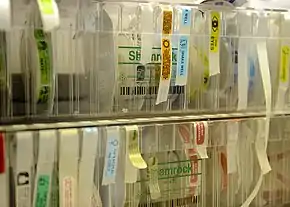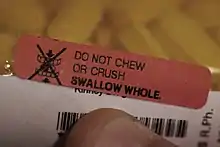Auxiliary label
An auxiliary label (also called cautionary and advisory label or prescription drug warning label) is a label added on to a dispensed medication package by a pharmacist in addition to the usual prescription label. These labels are intended to provide supplementary information regarding the safe administration, use, and storage of the medication.[1] Auxiliary labels provide information which can augment but not replace verbal counselling from a pharmacist.[2]

History
Auxiliary labels became popular during the second half of the nineteenth century.[3]
In 2013, the first recommendations for auxiliary label usage in the United States were published as USP Chapter <17>.[4] This included a recommendation to limit the use of auxiliary labels to evidence-based labels with critical information, and without pictures unless evidence shows increased efficacy when a picture is used. It is further recommended that labels are placed in a manner obvious to the patient without having to turn or rotate the package.[4]
Contents

.jpg.webp)
Auxiliary labels are generally small stickers consisting of a pictogram and one or more lines of text intended to enhance patient knowledge. They generally contain information not contained in the "directions" on the prescription label itself. This can include supplementary directions for administration, whether the medication can be chewed, crushed, or cut, and information on side effects or drug/food interactions.[5][6] All auxiliary labels contain information important to proper medication adherence, or to avoid adverse drug reactions.[7] There is not one guideline for how to best formulate auxiliary labels on a prescription, but the label should be as simple as possible and written in plain language.[6]
A 2016 study found that many patients consider side effects to be important information on a prescription package and that auxiliary labels are a good tool to provide this information on the packaging itself (as opposed to a separate information sheet/handout).[8] The same study found that patients associated the use of red as a highlight color with information regarding warnings, allergies, or side effects.[8]
Some auxiliary labels are used not to add additional information to the package, but to provide a pictorial representation of the instructions for use.[9] Picture representations of directions can be useful for patients with low literacy, or who have trouble reading and comprehending text instructions due to age, eyesight, or other factors.[9]
Usage
Deciding what auxiliary labels are suitable for a particular prescription requires knowledge of the drug's classification, interactions, and side effects.[10] One study of auxiliary label usage found that about 80% of prescriptions require at least one auxiliary label to provide important information aside from the directions for use.[6] The most common auxiliary labels on prescriptions include "May cause drowsiness" and "alcohol may intensify the effect of this medication".[6]
Auxiliary labels placed on a prescription vial may be placed vertically, horizontally, or on the vial cap ("interactive placement"). Placement of the label in an interactive manner where the patient must interact with it to open the vial is more likely to be noticed and comprehended by the patient.[4] Both horizontal and interactive placement are superior to vertical placement, which may be due to the need to rotate the vial to read the information on the label.[4] One study in 2007 found that 82% of prescriptions had auxiliary labels placed vertically, requiring the bottle to be tilted to read the text. The same study found a wide variation in coloring used on auxiliary labels from different pharmacies, and that between 8-25% of prescriptions filled had no warning labels at all.[11]
The use of auxiliary labels does not substitute for pharmacist consultation about medications, nor for any supplemental medication guides or handouts recommended or required to be distributed with a drug. Auxiliary labels should only be used to remind or enhance instructions for use or warnings that have already been given by the pharmacist or doctor to the patient verbally.[12]
Effectiveness
Auxiliary labels can commonly be misinterpreted, especially when multi-step or multi-part instructions are present on one label.[7] Misinterpretation of auxiliary labels can occur when patients are unable to understand the wording of the label, and thus assume an instruction based on the pictogram or color of the label.[7] In addition to misinterpretation, some studies have found that most patients ignore auxiliary labels on prescriptions completely, especially those with low health literacy.[5] This may be due in part to the belief that information presented on the bottle is not important, or due to the manner in which the labels are affixed to the vial.[5] When auxiliary labels are used as a reminder to the patient of important information, failure to understand and follow the instructions from auxiliary labels can result in treatment failure or adverse effects.[5] The effectiveness of auxiliary labels can vary greatly between different label formats and specific text, with a 2006 survey finding that one common multi-step, complex label ("Do not take dairy products, antacids, or iron preparations within 1 hour of this medication") was interpreted correctly only 7.6% of the time.[7]
The overall effectiveness of auxiliary labels depends on the number of labels affixed, the design of the label, and their positioning on the medication package or vial.[13] Simplifying the content and number of auxiliary labels can improve patient comprehension.[14] In the United States, many labels are commonly only stocked in English, which can decrease the chance of understanding in areas with significant non-English speaking populations. Only one third of auxiliary labels in the United States are available in languages other than English.[7]
Common elements considered to increase the chance of effectiveness of an auxiliary label include a single-step instruction, using easy-to-read text (for example, low Lexile score), use of clear, simple icons (if present), use of color to represent severity, and clarity of the instruction being represented.[15] Font size and style, including boldface or capitalization patterns, can also impact the effectiveness of an auxiliary label.[15] The effectiveness of auxiliary labels is also increased when pharmacists explicitly instruct patients on their presence on the package, and explain the importance of each of the warnings being presented using the auxiliary labels.[12] It has also been recommended that people with low health literacy and low literacy in general be consulted during the design process for auxiliary labels to improve the chance for comprehension and effectiveness.[7]
References
- "The Pharmaceutics and Compounding Laboratory". pharmlabs.unc.edu. Archived from the original on 2017-05-16. Retrieved 2016-04-18.
- "Guiding Principles for Assigning Auxiliary Labels for Outpatient Medications at BCCA" (PDF). BC Cancer Agency. Archived from the original (PDF) on 28 April 2016. Retrieved 18 April 2016.
- Griffenhagen, George; Bogard, Mary (1999). History of drug containers and their labels. Madison, Wis.: American Inst. of the History of Pharmacy. p. 35. ISBN 0931292263.
- Lee, Jiyon; Ladoni, Moslem; Richardson, James; Sundar, Raghav P.; Bix, Laura (30 June 2019). "Investigating the efficacy of an interactive warning for use in labeling strategies used by us pharmacies". Pharmacy Practice. 17 (2): 1463. doi:10.18549/PharmPract.2019.2.1463. PMC 6594438. PMID 31275502.
- Davis, Terry C.; Wolf, Michael S.; Bass, Pat F.; Thompson, Jason A.; Tilson, Hugh H.; Neuberger, Marolee; Parker, Ruth M. (19 December 2006). "Literacy and Misunderstanding Prescription Drug Labels". Annals of Internal Medicine. 145 (12): 887–894. doi:10.7326/0003-4819-145-12-200612190-00144. PMID 17135578. S2CID 3472412.
- Borgsteede, Sander D.; Heringa, Mette (August 2019). "Nature and frequency of dosing instructions on prescription labels in primary care". Pharmacoepidemiology and Drug Safety. 28 (8): 1060–1066. doi:10.1002/pds.4796. PMID 31134701. S2CID 167221843.
- Davis, Terry C.; Wolf, Michael S.; Bass, Pat F.; Middlebrooks, Mark; Kennen, Estela; Baker, David W.; Bennett, Charles L.; Durazo-Arvizu, Ramon; Bocchini, Anna; Savory, Stephanie; Parker, Ruth M. (August 2006). "Low literacy impairs comprehension of prescription drug warning labels". Journal of General Internal Medicine. 21 (8): 847–851. doi:10.1111/j.1525-1497.2006.00529.x. PMC 1831578. PMID 16881945.
- Kebodeaux, Clark D.; Peters, Golden L.; Kindermann, Heather A.; Hurd, Peter D.; Berry, Tricia M. (May 2016). "Patient-perceived content and formatting expectations for prescription container labeling". Journal of the American Pharmacists Association. 56 (3): 242–247.e1. doi:10.1016/j.japh.2016.01.007. PMID 27067553.
- Katz, Marra G.; Kripalani, Sunil; Weiss, Barry D. (1 December 2006). "Use of pictorial aids in medication instructions: A review of the literature". American Journal of Health-System Pharmacy. 63 (23): 2391–2397. doi:10.2146/ajhp060162. PMID 17106013.
- Hopper, Teresa (2012). Mosby's pharmacy technician : principles and practice (3rd ed.). St. Louis, Mo.: Elsevier Saunders. p. 217. ISBN 978-1437706703.
- Shrank, William H. (10 September 2007). "The Variability and Quality of Medication Container Labels". Archives of Internal Medicine. 167 (16): 1760–5. doi:10.1001/archinte.167.16.1760. PMID 17846395.
- Wolf, Michael S. (11 January 2010). "Improving Prescription Drug Warnings to Promote Patient Comprehension". Archives of Internal Medicine. 170 (1): 50–6. doi:10.1001/archinternmed.2009.454. PMC 3845799. PMID 20065199.
- "Rationalizing the use of Auxiliary Labels for oral oncology drugs" (PDF) (Conference poster). BC Cancer Agency. Retrieved 18 April 2016.
- Locke, Michelle R.; Shiyanbola, Olayinka O.; Gripentrog, Elizabeth (May 2014). "Improving prescription auxiliary labels to increase patient understanding". Journal of the American Pharmacists Association. 54 (3): 267–274. doi:10.1331/JAPhA.2014.13163. PMID 24816353.
- Wolf, Michael S.; Davis, Terry C.; Tilson, Hugh H.; Bass, Pat F.; Parker, Ruth M. (1 June 2006). "Misunderstanding of prescription drug warning labels among patients with low literacy". American Journal of Health-System Pharmacy. 63 (11): 1048–1055. doi:10.2146/ajhp050469. PMID 16709891.